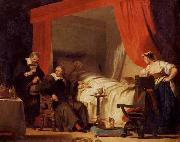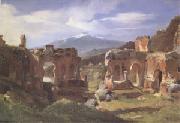| |
|
Xiamen Oil Paintings, Wholesale Direct!
|
|
100% hand painted, 100% cotton canvas, 100% money back if not satisfaction. |
|
|
|
|
ART WORKS INDEX
A
B
C
D
E
F
G
H
I
J
K
L
M
N
O
P
Q
R
S
T
U
V
W
X
Y
Z
|
|
ARTISTS INDEX
A
B
C
D
E
F
G
H
I
J
K
L
M
N
O
P
Q
R
S
T
U
V
W
X
Y
Z
|
|
|
|
 |
allart van everdingen
|
|
Allaert van Everdingen (bapt. 18 June 1621 Alkmaar - buried 8 November 1675, Amsterdam), was a Dutch Golden Age painter and printmaker in etching and mezzotint.
Van Everdingen was the son of a government clerk at Alkmaar. He and his older brothers, the painters Jan and Caesar van Everdingen, according to Arnold Houbraken, were taught by Roelandt Savery at Utrecht. Allaert moved in 1645 to Haarlem, where he studied under Pieter de Molijn, and finally settled about 1657 at Amsterdam, where he died in 1675.
|
|
 |
Alfred Elmore
|
|
Irish-born British Painter, 1815-1881
was a Victorian history and genre painter. He was born in Cork, Ireland, the son of Dr. John Richard Elmore, a surgeon who retired from the British Army to Clonakilty. His family moved to London, where Elmore studied at the Royal Academy of Arts. His early works were in the troubadour style of Richard Parkes Bonington, but he soon graduated to religious work, notably The Martyrdom of Thomas Becket, commissioned by Daniel O'Connell for Westland Row Church in Dublin. Between 1840 and 1844 Elmore travelled across Europe, visiting Munich, Venice, Bologna, and Florence. Elmore seems to have been associated with The Clique, a group of young artists who saw themselves as followers of Hogarth and David Wilkie. According to his friend William Powell Frith he was member of the group, but since it was most active while he was in continental Europe, his involvement was probably short-lived. Most of Elmore's later works were historical narrative paintings. Religious Controversy and The Novice were implicitly anti-Catholic in character. Other paintings set episodes from Shakespeare, or the history of the French Revolution. They often contained subtle explorations of the process of creation, most importantly his two paintings about technological innovation, The Invention of the Stocking Loom (1847, Nottingham Castle Museum) and The Invention of the Combing Machine (1862, Cartwright Hall, Bradford). Both portray the process of industrialisation by depicting picturesque pre-industrial handicrafts. The inventor is supposed to be pondering these manual skills while he forms in his mind a mechanism to replace them. Elmore's best-known work is On the Brink (1865; Fitzwilliam Museum, Cambridge), a moral genre painting depicting a young woman who has lost her money gambling, and is 'on the brink' of responding to the blandishments of a seducer, who is depicted as a satan-like figure,
|
|
 |
Alfred Edward Emslie
|
|
Alfred Edward Emslie (1848 London -1918) was an English genre and portrait painter, and photographer, living at The Studio, 34, Finchley Road, N. W.
He was the son of the engraver, John Emslie, and brother of John Phillipps Emslie, the figure painter. Married to miniature painter Rosalie M. Emslie, they had a daughter, Rosalie Emslie, who became a figure, portrait and landscape painter. Emslie turned increasingly to portraiture later in life. He had a great passion for the Orient, and spent three months exploring Japan. He was a elected an associate of the Royal Society of Painters in Water Colours in 1888 and a member of the Royal Society of Portrait Painters in 1892.
|
|
|
|
 |
Alfred East
|
|
(December 15, 1849 C September 28, 1913) was an English painter.
He was born in Kettering in Northamptonshire and studied at the Glasgow School of Art. His romantic landscapes show the influence of the Barbizon school. His The Art of Landscape Painting in Oil Colour was published in 1906. In April 1888 he had shared an exhibition at the galleries of the Fine Art Society with T.C. Gotch and W. Ayerst Ingram, and was commissioned the following year by Marcus Huish, Managing Director of the Society, to spend six months in Japan to paint the landscape and the people of the country. When the exhibition of 104 paintings from this tour was held at the Fine Art Society in 1890 it was a spectacuar success. He was awarded a Knighthood in 1910 by King Edward VII. His portrait was painted by Philip de Laszlo. On Sunday, 28 September 1913, Alfred East died at his London residence in Belsize Park.
|
|
 |
Alexandre-Evariste Fragonard
|
|
French Painter, 1780-1850,son of Jean-Honore Fragonard, was a French painter and sculptor in the troubadour style. He received his first training from his father and drew from him his piquant subjects and great facility, perfecting them under David.
|
|
|
|
 |
Albin Egger Lienz
|
|
Albin Egger-Lienz (29 January 1868 - 4 November 1926) was an Austrian painter.
He was born in Dölsach-Stribach near Lienz, in what was the county of Tyrol. As an artist, he had a special preference for rustic genre and historical paintings; under the influence of Ferdinand Hodler, Egger-Lienz abstracted his formal language into monumental expressiveness.
He trained first under his father (a church painter), later he studied at the Academy in Munich where he was influenced by Franz Defregger and French painter Jean-François Millet. In 1899 he moved to Vienna. During 1911 and 1912 he was professor at the Weimar School of Fine Arts and he served as war painter during World War I. In 1918, he turned down a professorship at the Vienna Academy and settled in South Tyrol. Egger-Lienz died on 4 November 1926 in St. Justina-Rentsch, Bolzano, Italy.
|
|
|
|
 |
Albert Edelfelt
|
|
1854-1905
Finnish
Albert Edelfelt Location
Finnish painter, illustrator and etcher. He was Finland leading artist in the late 19th century, introducing French influences into Finnish art but also helping to gain a broader international interest in his country culture. He was not a great innovator, however, and although his reputation in Finland remained firm, international recognition dwindled after his death until the renewal of interest in realism that took place in the late 20th century.
|
|
 |
Albert Eckhout
|
|
Groningen, 1610 - 1666,was a Dutch portrait and still life painter. Eckhout was among the first European artists to paint scenes from the New World. In 1636, he traveled to Dutch Brazil, invited by count John Maurice, Prince of Nassau-Siegen. There, he painted portraits of natives, slaves and mulattos. He is also famous for his still lifes of Brazilian fruits and vegetables. The majority of his work is now stored at the National Museum of Denmark in Copenhagen. In art history, he is taken to be part of Baroque.
|
|
|
|
|
|
|
|
 |
Adam Elsheimer
|
|
German Baroque Era Painter, 1578-1610
German painter, printmaker and draughtsman, active in Italy. His small paintings on copper established him after his brief life as the most singular and influential German artist to follow D?rer. Their grand conception in terms of monumental figures and poetic landscape and their meticulous, miniature-like execution were admired by Rubens and came to influence many 17th-century artists, including Rembrandt.
|
|
 |
Achille-Etna Michallon
|
|
Paris 1796-1822
was a French painter. Michallon was the son of the sculptor Claude Michallon. He studied under Jacques-Louis David and Pierre-Henri de Valenciennes. In 1817, Michallon won the inaugural Prix de Rome for landscape painting. He travelled to Italy in 1818 and remained there for over two years. This trip had a profound influence on his work. Before he had much time to develop what he had learned however, he died at the age of 26 of pneumonia, a tragedy which cut short the life of a talented and well respected artist who could have gone on to win lasting fame. Though it is often disputed, it is thought that at one time, Corot was his pupil.
|
|
|
|
 |
Abbey, Edwin Austin
|
|
American Golden Age Illustrator and Muralist, 1852-1911
American painter and illustrator, active in England. He began his artistic training in 1866, studying drawing with the Philadelphia portrait and landscape painter Isaac L. Williams (1817-95). In 1868 he attended evening classes in drawing at the Pennsylvania Academy of the Fine Arts under Christian Schussele (1824-79). In the same year Abbey began to work as an illustrator for the Philadelphia publishers Van Ingen & Snyder. In 1870 Harper's Weekly published the Puritans' First Thanksgiving, and in 1871 Abbey moved to New York to join the staff of Harper & Brothers, thus inaugurating his most important professional relationship. Throughout the 1870s Abbey's reputation grew, both for his detailed exhibition watercolours and for his elegant line drawings, which, translated to wood-engravings in numerous periodicals, illustrated both factual and fictional events of the past and present. The influences on him were mainly English, in particular the works of the Pre-Raphaelite Brotherhood and illustrations in the English press, which he studied avidly. The success of his illustrations to some of Robert Herrick's poems, such as Corinna's Going A-Maying in Harper's New Monthly Magazine (May 1874), prompted Harper & Brothers in 1878 to send Abbey to England to do a complete series of drawings for an illustrated gift-book, Selections from the Poetry of Robert Herrick (New York, 1882).
|
|
|
|
|
|
|
|
|
|
|
|
|
| Wholesale China Oil Painting Wholesale Oil Painting China Xiamen Portrait Reproduction on canvas Chinese Oil Painting Wholesale USA Oil Painting |
|
|
|
|
|